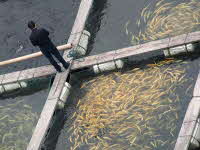FARM RAISED FISH SAFETYEarthTalk, (June 12, 2011) Dear EarthTalk:
I thought “farm raised” was the way to go when buying fish, to avoid mercury contamination. But are there other concerns about farm raised that make some fish a poor choice for good health? What are the safest fish to buy and which should be avoided? And what about those frozen blocks of fish I get at Trader Joe’s? Are they safe to eat?
-- Tim Jeffries, Springfield, MA
Mercury is a neurotoxin that settles into the ocean in large concentrations after we spew it out of industrial smokestacks when burning fossil fuels like coal and oil. It is then taken up by smaller sea life such as plankton and then spread up through the food chain as larger fish eat smaller ones. We humans then eat the mercury-laced seafood—wild salmon, tuna, swordfish and other fish—and breathe it in our air. Repeated exposure to mercury pollution can cause brain, kidney and developmental problems for people.
 A fish farm in Shanghai A fish farm in Shanghai
Farm-raised fish can still absorb mercury, since most fish farms are located in the ocean, close to or abutting the shoreline. They can also absorb PCBs and dioxins, as the near-shore waters they occupy are the first stop for run-off from land-based sources of pollution.
Photo: Ivan Walsh, courtesy Flickr
|
|
Farm-raised fish may have somewhat less exposure to mercury than their wild free-foraging cousins because they are usually fed a controlled diet, often consisting of more grains and soy, a cheaper and more abundant source of calories, than fishmeal. But they can still absorb mercury, since most fish farms are themselves located in the ocean, just close to or abutting the shoreline.
Farmed fish can also absorb PCBs and dioxins, as the near-shore waters they occupy are the first stop for run-off from land-based sources of pollution. And the fact that their primary feed source comes from conventionally grown terrestrial crops means that their diets can include trace amounts of pesticides and herbicides as well.
Also, most farmed fish are exposed to dose after dose of antibiotics to keep diseases and pests at bay in their crowded underwater pens, much in the way “factory farmed” land animals are drugged to help them cope with cramped, unsanitary conditions. In fact, studies have shown that farm-raised fish have more toxins overall than their wild-caught cousins, though exceptions of course do exist.
The best way to know which fish are safe and which are not is to download a region-specific seafood buying guide from the Monterey Bay Aquarium’s Seafood Watch program. These guides aid the decision-making process when shopping for seafood in a store or ordering it at a restaurant by dividing the fish available in that part of the country into three categories: Best Choices, Good Alternatives and Avoid.
And bring your Seafood Watch guide to Trader Joe’s as well—at least for now. In 2010, after months of lobbying by Greenpeace and a growing number of concerned shoppers, Trader Joe’s agreed to offer only “sustainable” seafood in its stores by the end of 2012. To its credit, they already removed endangered Chilean Sea Bass from shelves in 2005, followed by Orange Roughy in 2009 and Red Snapper in 2010.
In the spirit of its recent pledge, however, Trader Joe’s is now working with third-party, science-based organizations to establish definitions and parameters for addressing customer concerns about overfishing, destructive catch or production methods, and the importance of marine reserves. Until 2013 at Trader Joe’s—and indefinitely at other stores that haven’t made specific commitments regarding the sustainability of their seafood—make sure to check that labels disclose the type of fish for sale and its source in regard to wild or farm-raised, and then check that info against the Seafood Watch list.
CONTACTS: Seafood Watch, www.seafoodwatch.org/ ; Trader Joe’s “Note to Our Customers about Trader Joe's Seafood,” www.traderjoes
EarthTalk® is written and edited by Roddy Scheer and Doug Moss and is a registered trademark of E - The Environmental Magazine (www.emagazine.com). Send questions to: earthtalk@emagazine.com . Subscribe: www.emagazine.com/subscribe.
Free Trial Issue: www.emagazine.com/trial | 